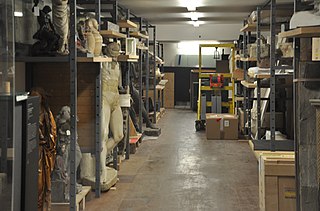 W
WA museum is distinguished by a collection of often unique objects that forms the core of its activities for exhibitions, education, research, etc. This differentiates it from an archive or library, where the contents may be more paper-based, replaceable and less exhibition oriented, or a private collection of art formed by an individual, family or institution that may grant no public access. A museum normally has a collecting policy for new acquisitions, so only objects in certain categories and of a certain quality are accepted into the collection. The process by which an object is formally included in the collection is called accessioning and each object is given a unique accession number.
 W
WBird collections are curated repositories of scientific specimens consisting of birds and their parts. They are a research resource for ornithology, the science of birds, and for other scientific disciplines in which information about birds is useful. These collections are archives of avian diversity and serve the diverse needs of scientific researchers, artists, and educators. Collections may include a variety of preparation types emphasizing preservation of feathers, skeletons, soft tissues, or (increasingly) some combination thereof. Modern collections range in size from small teaching collections, such as one might find at a nature reserve visitor center or small college, to large research collections of the world's major natural history museums, the largest of which contain hundreds of thousands of specimens. Bird collections function much like libraries, with specimens arranged in drawers and cabinets in taxonomic order, curated by scientists who oversee the maintenance, use, and growth of collections and make them available for study through visits or loans.
 W
WCabinets of curiosities were collections of notable objects. The term cabinet originally described a room rather than a piece of furniture. Modern terminology would categorize the objects included as belonging to natural history, geology, ethnography, archaeology, religious or historical relics, works of art, and antiquities. The classic cabinet of curiosities emerged in the sixteenth century, although more rudimentary collections had existed earlier. In addition to the most famous and best documented cabinets of rulers and aristocrats, members of the merchant class and early practitioners of science in Europe formed collections that were precursors to museums.
 W
WThe hobby of collecting includes seeking, locating, acquiring, organizing, cataloging, displaying, storing, and maintaining items that are of interest to an individual collector. Collections differ in a wide variety of respects, most obviously in the nature and scope of the objects contained, but also in purpose, presentation, and so forth. The range of possible subjects for a collection is practically unlimited, and collectors have realised a vast number of these possibilities in practice, although some are much more popular than others.
 W
WA collection manager ensures the proper care and preservation of objects within cultural institutions such as museums, libraries, and archives. Collection managers, along with registrars, curators, and conservators, play an important role in collections care. Collection Managers and Registrars are two distinct collection roles that are often combined into one within small to mid-size cultural institutions. Collection Managers can be found in large museums and those with a history and natural history focus whose diverse collections require experienced assessment to properly sort, catalog, and store artifacts. A collection manager may oversee the registrar, archivist, curator, photographer, or other collection professionals, and may assume the responsibilities of these roles in their absence within an organization.
 W
WCollections management involves the development, storage, and preservation of collections and cultural heritage. The primary goal of collections management is to meet the needs of the individual collector or collecting institution's mission statement, while also ensuring the long-term safety and sustainability of the cultural objects within the collector's care. Collections management, which consists primarily of the administrative responsibilities associated with collection development, is closely related to collections care, which is the physical preservation of cultural heritage. The professions most influenced by collections management include collection managers, registrars, and archivists.
 W
WWentworth and Reform Gold Mines is a heritage-listed former Gillies artefact collection, churchyard and now abandoned gold mine at 4570-4578 Mitchell Highway, Lucknow, City of Orange, New South Wales, Australia. It was designed by H. W. Newman, Alexander Marshall and Frederick McFadzean and built from 1890 to 1940. Machinery includes a Thompson's winding engine from Castlemaine. It is also known as Main Mine or Wentworth Main Mine; Industrial Archaeological Site. The site is owned by the Orange City Council and was added to the New South Wales State Heritage Register on 24 August 2018.